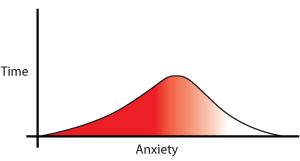These are things that your emotions compel you to do. Ideally, your emotions drive you to respond in an adaptive way, like running out of a burning building which is adaptive and helps you survive. You would likely do this without a second thought or weighing the pros and cons of staying or going. Sometimes, though, your emotion-driven behaviours aren’t so helpful and can actually be counterproductive in helping you respond to an event.
Emotionally driven behaviours are different from emotional avoidance. This is because emotional avoidance aims to prevent the emotion from happening in the first place or from it getting any stronger. While this works really well in the short-term, it only serves to maintain and strengthen the problem. In contrast, emotionally driven behaviours typically happen in response to an emotion that was triggered.
Let’s look at this example. Imagine that you’re in a really crowded subway in the middle of winter. Because you’re wearing your winter jacket and it’s so crowded, you notice that you start to feel hot and sweaty. The air is getting stuffy and you’re wondering if you’re breathing is getting more difficult. As this is happening, you start to think that these feelings were similar to those you had last time you were feeling anxious, and so you start to worry that you’re going to have a panic attack right there in the middle of the crowded subway. Your anxiety starts to creep up and you notice that your heart is racing and you’re feeling a little light-headed. Now, it seems to you that the panic attack must be imminent. As soon as the train arrives at its next stop, you push your way out, gasping for air and thank your lucky stars that you managed to escape before the panic attack came.
| Emotional avoidance in this situation might include using a safety behaviour such as bringing someone you trust or who makes you feel calmer to avoid feeling anxious in the first place. | |
| But in this example, the increasing anxiety and fear of having a panic attack drove you to get off the train, even though it wasn’t your stop – an emotion-driven behaviour. As soon as you got off, your anxiety started to decrease. Mission accomplished. If we looked at a graph of your anxiety, it would probably look something like this: |
 |
| The problem with getting off the subway car and having your anxiety decrease is that you missed out on a valuable learning opportunity and inadvertently reinforced your fear. Although, in the moment, it might have seemed like the anxiety would have kept increasing forever, by leaving the situation you didn’t get to see that the anxiety would have come down all by itself, if you had waited it out. | |
 |
Had you experienced that, you would have also learned that you weren’t in any actual danger and that your worst fears didn’t happen. By leaving, you just reinforced to yourself that when you experience those physical feelings of being hot, sweaty and having a little difficulty breathing, that you’re in imminent risk of a panic attack and must leave. One additional problem is that you might notice that you have these symptoms in other situations, so you might start avoiding those, as well, thinking, “Better safe than sorry.” Do this often enough and your world will become really small and might not extend past your home. |
